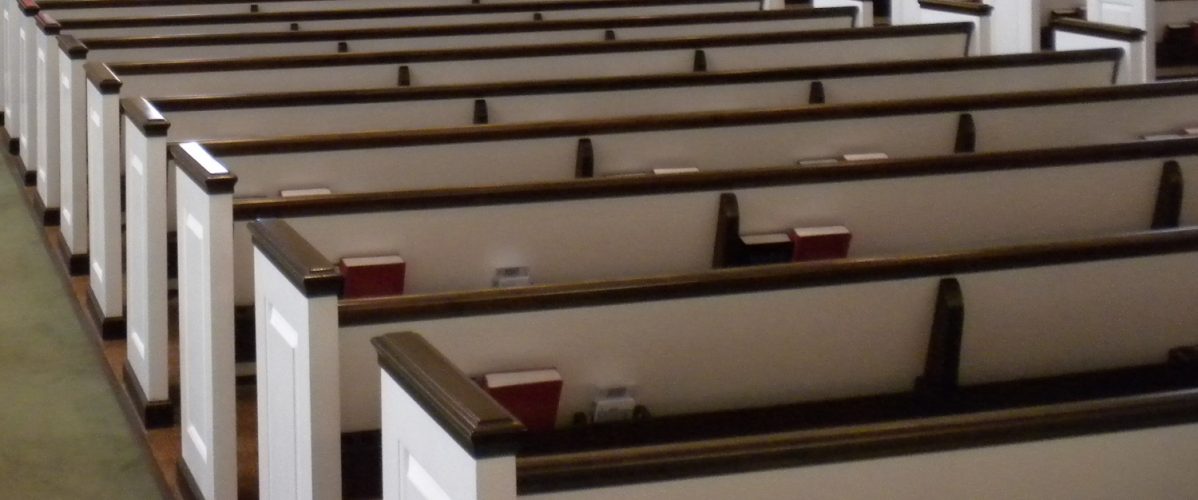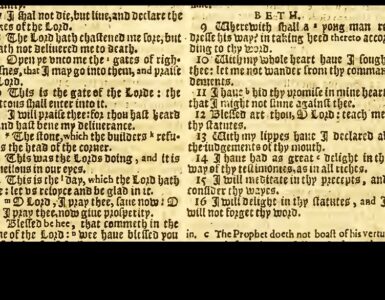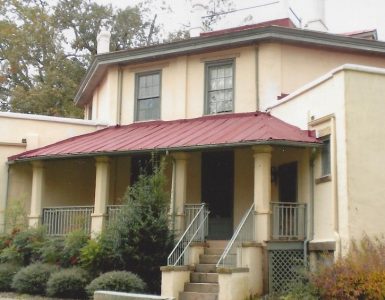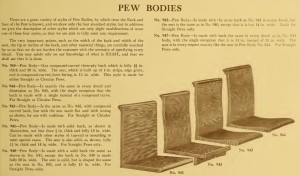 According to Noah Webster’s An American Dictionary of the English Language, “pew” was defined as “an enclosed seat in a church” that had been in the past “made square” by boxing them in with panels and providing a door for access. His dictionary goes on to add that in “modern churches in America” seating was provided with pews which were generally “long and narrow, and sometimes called slips.” A visit to a colonial era church such as Bruton Parish in Williamsburg, or the earlier Puritan era example of the Old Ship Meeting House in Hingham, Massachusetts, shows the boxed-in construction of pews that contained the heat radiated from portable foot warmers in winter. Over the years, the definition of a pew has been refined to describe the church furniture we recognize today. The current Concise Oxford English Dictionary describes a “pew” as “a long bench with a back, placed in rows in churches for the congregation.” Generally, pews are austere to mildly decorated backed benches, set in rows, accessed by aisles, and designed to accommodate the congregation in worship with the most efficient use of floor space while providing some degree of comfort.
According to Noah Webster’s An American Dictionary of the English Language, “pew” was defined as “an enclosed seat in a church” that had been in the past “made square” by boxing them in with panels and providing a door for access. His dictionary goes on to add that in “modern churches in America” seating was provided with pews which were generally “long and narrow, and sometimes called slips.” A visit to a colonial era church such as Bruton Parish in Williamsburg, or the earlier Puritan era example of the Old Ship Meeting House in Hingham, Massachusetts, shows the boxed-in construction of pews that contained the heat radiated from portable foot warmers in winter. Over the years, the definition of a pew has been refined to describe the church furniture we recognize today. The current Concise Oxford English Dictionary describes a “pew” as “a long bench with a back, placed in rows in churches for the congregation.” Generally, pews are austere to mildly decorated backed benches, set in rows, accessed by aisles, and designed to accommodate the congregation in worship with the most efficient use of floor space while providing some degree of comfort.
Despite the common use of pews in American church buildings their use for the seating of all members in worship developed over time as a result of the Reformation. Margo Todd’s The Culture of Protestantism in Early Modern Scotland provides a glimpse of changes in church seating. Todd opened her section on the topic commenting that, “The Scottish Reformation was an era of pew-building” (318). However, the seating of the era varied in design within a church and from one church to the next. If one was wealthy and socially prominent, then one would have a seat or gallery constructed in the church that might be decorated with the family crest and have an attached canopy. Some of these seats were elevated, had their own staircases, and private entrances from outside the building (319). These extravagant lounges for the socially prominent, royals, or other wealthy members were built according to plans approved by the church elders and then crafted by jointers contracted by those desiring the new seating. In some cases, the elders required the plans to be changed so proposed high backs, canopies, and other tall elements would not obstruct the view of the pulpit by the congregation (321).
At the other end of the economic spectrum were the poor who might have no seat at all or carried stools with them to church where they would hopefully find a spot of floor (323). In some cases there were seating disagreements that led to violence. Circa 1630, Elspeth Kettle found her stool occupied by Barbara Stewart, whom she forced from it, pulled it from her grasp as they fought, and jabbed her with a knife on the side of the head. Stewart responded by stabbing Kettle’s ears with a needle so that she bled (323). The transition from personally owned seating to common seating owned by the church was similar to other changes produced by the Reformation in that it was evolutionary and not revolutionary.
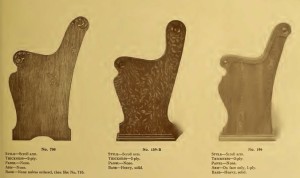 The Architecture of Scottish Post-Reformation Churches, 1560-1843, by George Hay, provides some interesting comments regarding the development of the use of pews. He notes that there were special pews for those marrying, being baptized, and repenting of sin. In the case of the repentant person a “cutty stool” was placed in an elevated location in clear view of the congregation so that the contrite individual could be seen by the rest of the congregation. The repentance stool or bench was sometimes placed in a special box pew clearly visible to the other worshippers. Hay notes that the National Museum of Scotland held in his day a stool from Greyfriars, Edinburgh, that he believed dated from the eighteenth century, and that the city church of St. Andrews had a bench used for the same purpose (196). Todd comments that the purpose of the stool was to provide a seat for the repentant “for the duration of the service for which their ‘humiliation’ had been prescribed” (131). As the years passed in Scotland, the specialized seating moved from places of dedicated prominence to specific seats in the congregational pews, and on, thankfully, out the door and into history. It may be that the use of the anxious bench in revivals led by C. G. Finney and others in antebellum America traces its origin to the “cutty stool” of Scotland. Finney would single out individuals in revival meetings and have them sit on the anxious bench much as the repentant person on the cutty stool could be viewed by the congregation.
The Architecture of Scottish Post-Reformation Churches, 1560-1843, by George Hay, provides some interesting comments regarding the development of the use of pews. He notes that there were special pews for those marrying, being baptized, and repenting of sin. In the case of the repentant person a “cutty stool” was placed in an elevated location in clear view of the congregation so that the contrite individual could be seen by the rest of the congregation. The repentance stool or bench was sometimes placed in a special box pew clearly visible to the other worshippers. Hay notes that the National Museum of Scotland held in his day a stool from Greyfriars, Edinburgh, that he believed dated from the eighteenth century, and that the city church of St. Andrews had a bench used for the same purpose (196). Todd comments that the purpose of the stool was to provide a seat for the repentant “for the duration of the service for which their ‘humiliation’ had been prescribed” (131). As the years passed in Scotland, the specialized seating moved from places of dedicated prominence to specific seats in the congregational pews, and on, thankfully, out the door and into history. It may be that the use of the anxious bench in revivals led by C. G. Finney and others in antebellum America traces its origin to the “cutty stool” of Scotland. Finney would single out individuals in revival meetings and have them sit on the anxious bench much as the repentant person on the cutty stool could be viewed by the congregation.
As churches included pews among their furnishings in the American colonies it brought about another practice that continued the class system of seating seen in Todd’s comments on Scotland. In Colonial America and well into the nineteenth century, the churches sometimes charged rent for the use of pews. The fees, pew rentals, were paid according to the depth of the pockets and level of concern for the best seating location for the lessee. The better seats had higher annual rents than the lesser locations so that an individual or family could sit where the fee was within budget. In some cases, the fees for the seats were not set but were instead established through bidding—the highest bidder had the best seat, or at least the best seat that could be afforded. The revenue from the rents was most often dedicated to the maintenance and upkeep of the church property. The fees were collected in different ways, but a few examples collected from church pew rental receipts show that fees of from 6.00 to 6.75 were paid quarterly between 1830 and 1859. Some extant nineteenth-century and earlier church buildings have the rows of pews numbered which allowed the renter to select seating according to the row and seat number much like one might purchase a ticket for the seat desired for the symphony.
The New Testament book of James has something to say regarding seating in the church. In chapter two, verses 1-4, James addressed the church saying,
My brethren, show no partiality as you hold the faith in our Lord Jesus Christ, the Lord of glory. For if a man wearing a gold ring and fine clothing comes into your assembly, and a poor man in shabby clothing also comes in, and if you pay attention to the one who wears the fine clothing and say, ‘You sit here in a good place,’ while you say to the poor man, ‘You stand over there,’ or, ‘Sit down at my feet,’ have you not then made distinctions among yourselves and become judges with evil thoughts?”
James instructs his recipients that as the first century church struggled with recognizing the equality of its members as those who were all redeemed by the same grace of Christ, socio-economic status must not affect the common bond among the church members as worshippers of God. The letter of James in the New Testament was circulated among churches in Asia Minor in which business owners, government officials, slaves, and trade workers often worshipped together, so James’ point was and is that the socio-economic status of the worshippers was to be left at the church door. In Scotland, the transition from the personally owned seating of the past to pews owned as furniture by the church developed slowly, but the result was a better application of the inspired words of the Lord’s brother. The evolutionary changes from galleries for the rich and stools for the poor to pews owned by the church providing equal seating can be traced to the sola Scriptura emphasis of the Protestant Reformation. However, it may be that another step in the evolution of church seating must take place in the minds of church members. Anyone who has visited a church while travelling or as a prospect for membership when relocating may have experienced the discomfort of sitting in a pew only to have someone approach you saying, “Excuse me. You are sitting in my pew.”
Is the pew the final step in the evolution of church seating? No, there is another church seat, the stackable polyurethane cushioned chair upholstered with a heavy-duty-faux-tweed material. Pews are very expensive to purchase, they are fastened to the floor limiting their flexibility of use, and repairs can sometimes become a problem as the years pass. The new metal padded chairs are comfortable and convenient when compared to their oak, mahogany, walnut, pine, cypress, or poplar ancestors with their rectangular-slipping-sliding cushions. However, the problems of pews might be balanced by their benefits. A fixed pew can be pointed to by a church member commenting, “That is where I was sitting when I understood the gospel,” “That is where I was sitting when I saw my grandchild baptized,” or “That is where I was sitting when I participated in the memorial service for my son killed in Vietnam?” Such personal reminiscences cannot be attributed to a stackable chair that is never in the same location.
So, between the lovers of old pews and the proponents of portable chairs there is a conflict. The historic old wooden pews are sensual, historic, crafted, and emotive, but the modern chairs offer flexibility of use and are more comfortable with their foam cushions and fixed width of seating. Maybe the modern church chair is the final step in the evolution of equitable seating. If a congregation is building a new worship facility to replace its old one with pews it might be good for historic and covenant continuity to take a few of those old pews and use them strategically in the new building. Signs or plaques could explain the age of the pews and their importance as covenant reminders and remembrances of the members who have gone before.
Barry Waugh
The Pictures
The pews pictured here may or may not be original to their churches. Each of these churches is at least 150 years old. The photographs were taken by the author.
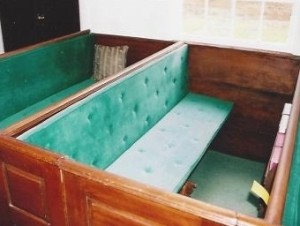 (A)—Webster’s definition described the pews as “formerly made square,” which would appear to be the type of pew in this picture taken in an eighteenth-century Presbyterian Church in South Carolina. An added benefit of the enclosed design would be reducing drafts around the feet and legs in the winter and containing any heat derived from a personal foot warmers.
(A)—Webster’s definition described the pews as “formerly made square,” which would appear to be the type of pew in this picture taken in an eighteenth-century Presbyterian Church in South Carolina. An added benefit of the enclosed design would be reducing drafts around the feet and legs in the winter and containing any heat derived from a personal foot warmers.
 (B)—These simple, unadorned, and basic pews were photographed in a tiny rural church in Virginia. The white walls, aged lumber, rustic floor, and light streaming in the windows show the simple needs for the worship of God.
(B)—These simple, unadorned, and basic pews were photographed in a tiny rural church in Virginia. The white walls, aged lumber, rustic floor, and light streaming in the windows show the simple needs for the worship of God.
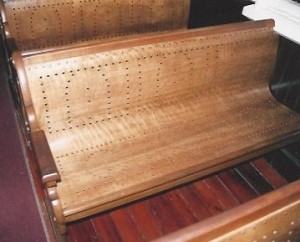 (C)—Necessity is the mother of invention and these perforated pews in a South Carolina church provide a wee bit of ventilation for perspiring worshipers during the hot and humid summers.
(C)—Necessity is the mother of invention and these perforated pews in a South Carolina church provide a wee bit of ventilation for perspiring worshipers during the hot and humid summers.
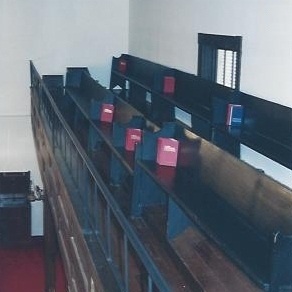 (D)—The two rows of pews behind the simple low railing were used originally by the enslaved. Sometimes separate entrance doors to the church building were provided.
(D)—The two rows of pews behind the simple low railing were used originally by the enslaved. Sometimes separate entrance doors to the church building were provided.
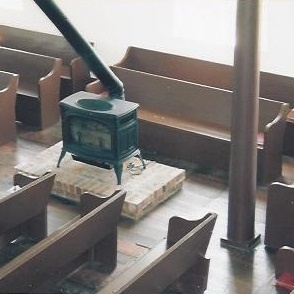 (E)—This church building with its black piped stove is located in rural North Carolina and was constructed for worship by immigrants of the German Reformed Church. A tour of the cemetery shows several grave markers inscribed in German. In the day, the men and women would separate for worship. It is out of the picture, but the long pews in the lower left are divided at the center of their length by a panel so the women and men could sit separately.
(E)—This church building with its black piped stove is located in rural North Carolina and was constructed for worship by immigrants of the German Reformed Church. A tour of the cemetery shows several grave markers inscribed in German. In the day, the men and women would separate for worship. It is out of the picture, but the long pews in the lower left are divided at the center of their length by a panel so the women and men could sit separately.
 (F)—A number on the end of the pew in this church in Georgia may go back to the days when church members paid pew rental fees for the upkeep of the church. The numbered pews were a way of assigning the seats. However, it may just be a practical way of accounting for the pews for maintenance, cleaning, and repairs.
(F)—A number on the end of the pew in this church in Georgia may go back to the days when church members paid pew rental fees for the upkeep of the church. The numbered pews were a way of assigning the seats. However, it may just be a practical way of accounting for the pews for maintenance, cleaning, and repairs.
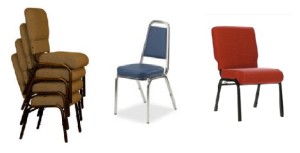 (G)—Are these the final step in the evolution of church seating? Their practicality, comfort, and lower cost make them particularly attractive for young churches.
(G)—Are these the final step in the evolution of church seating? Their practicality, comfort, and lower cost make them particularly attractive for young churches.
Sources—Noah Webster’s First Edition of an American Dictionary of the English Language, San Francisco: Foundation for American Christian Education, 1967, 1995, which is a reprint of An American Dictionary of the English Language, 2 volumes New York: S. Converse, 1828. Angus Stevenson and Maurice Waite edited the Concise Oxford English Dictionary, 12th edition, Oxford: Oxford University Press, 2011. George Hay, The Architecture of Scottish Post-Reformation Churches, 1560-1843, Oxford: Clarendon Press, 1957, see particularly pages 195-99. Margo Todd’s The Culture of Protestantism in Early Modern Scotland, New Haven: Yale University Press, 2002, is a fascinating study using many sources including local church sessional records. It provides a unique perspective on the transition of Scotland to its Protestant, Calvinist, and Presbyterian Kirk. Note that the UK National Archives defines Early Modern as 1485-1750.


